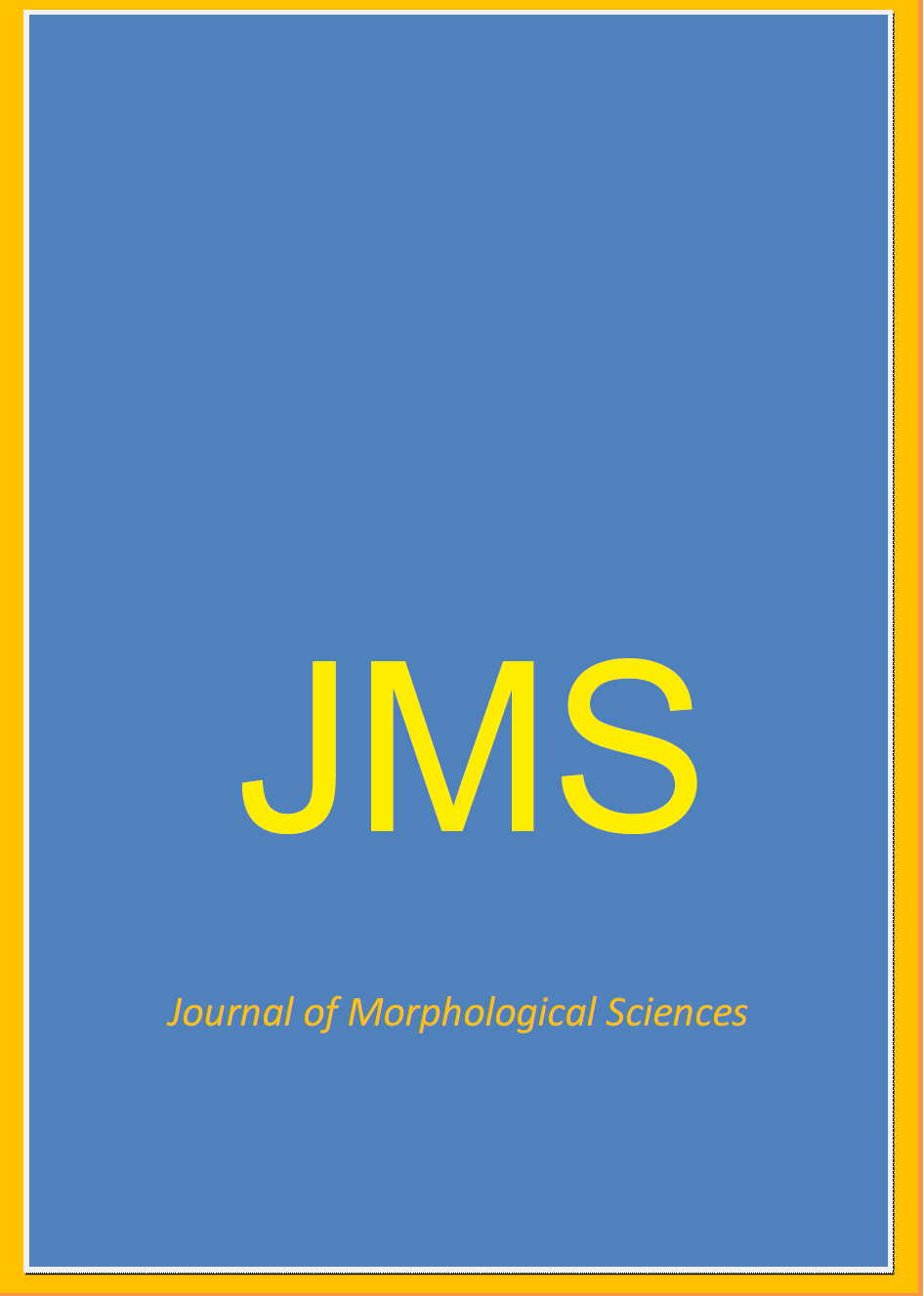DEEP BITE CORRECTION BY INCISORS INTRUSION WITH CONNECTICUT INTRUSION ARCH - case report
Abstract
Deep overbite as one of the most common malocclusion that can occur along with other associated malocclusions can be treated with several mechanisms. One such mechanics is true intrusion of anterior teeth. Deep overbite correction by intrusion of anterior teeth affords a number of advantages and is the desired treatment option for gummy smile correction, esthetics improvement as well as correction of mandible rotation in order to improve vertical dimension and to correct Class II malocclusion. This case report describes the orthodontic treatment of a 17-year-old patient diagnosed as severe Angle’s Class II malocclusion with maxillary prognathism and skeletal deep bite, dental Class II division 1 malocclusion associated with 4 mm overbite, an increased overjet and excessive gingival display on smiling. After the analyses and due to the fact that the patient avoided surgical method for her malocclusion correction, our treatment plan in this case was alternative (camouflage) with upper premolars extraction. In the first phase we did 9 mm canine retraction with preserved vertical dimensions of upper incisors. In the second phase of our treatment we did incisor intrusion and en masse retraction of the incisors. Intrusion of upper incisors was done using a 0.017 × 0.025 Connecticut intrusion arch and 0.019 x 0.025 stainless steel as base archwire was used. Outstanding results were achieved with an improved facial profile, smile harmony and stable occlusal relationships. Through this case report we highlight the efficiency of Connecticut intrusion arch as а clinically manageable biomechanical system to optimize the orthodontic treatment. The use of good biomechanical principles helped us to achieve all treatment goals and objectives with minimal side effects.
Keywords: deep bite, maxillary incisors intrusion, Connecticut intrusion arch
https://doi.org/10.55302/JMS2142135t
References
Orthod. 1988; 58(3):237–256. PMID: 3189955.
2. Proffit W, FIelds HJ, Moray LJ. Prevalence of malocclusion and orthodontic treatment need in the US. Int J
Adult Orthodon Orthognath Surg. 1998; 13:97–106. PMID: 9743642.
3. Dermaut LR, De Pauw G, Biomechanical aspects of Class II mechanics with special emphasis in deep bite
correction as part of the treatment goal. In: Nanda R ed. Biomechanics in clinical Orthodontics 1997
Philadelphia, PaW.B. Saunders Co:86-98.
4. Intrusive Arch versus Miniscrew-Supported Intrusion for Deep Bite Correction Manal Mohamed El
Namrawy,1,* Fouad El Sharaby,2 and Mohamed Bushnak3. Open Access Maced J Med Sci. 2019 Jun15;
7(11):1841–1846.
5. Nanda R., Correction of deep over bite in adults Dent Clin North Am 1997: 41:67-87.
6. Nanda R., Differential Diagnosis and treatment OD excessive overbite.
7. Uribe F, Nanda R, Treatment of Class II Division 2 Malocclusion in Adults Biomechanical consideration 2003;
37(11):599-606.
8. Schwertner A., Rodrigues de Almeida R, et al. Photoelastic analysis of stress generated by Connecticut
Intrusion Arch (CIA). Dental Press J.Orthod. 22(1) 2017.
9. Nandakumar Janakiraman, Pawandeep Gill, Madhur Upadhyay, Ravindra Nanda, Flavio Uribe; Response of
the maxillary dentition to a statically determinate one-couple system with tip-back mechanics: A prospective
clinical trial. Angle Orthod 1 January 2016; 86 (1):32–38.
10. Nanda R., Marzban R., Kuhlberg A., The Connecticut Intrusion arch J Clin. Orthod 1998 32:70815.
11. Janzen E. A balanced smile is a most important treatment objective. Am J Orthod. 1977; 72:359372.
https://doi.org/10.1016/0002-9416(77)90349-9. PMID: 269665.
12. Lindauer SJ, Lewis SM, Shroff B. Overbite correction and smile Aesthetics. Semin Orthod. 2005; 11:62–66.
https://doi.org/10.1053/j.sodo.2005.02.003.
13. Sarver D, Ackerman M. Dynamic smile visualization and quantification: Part I. Evolution of the concept and
dynamic records for smile capture. Am J Orthod Dentofac Orthop. 2003; 124(1):412.
https://doi.org/10.1016/S0889 5406(03)00306-8. PMID: 12867893.
14. Proffit WR, Fields HW, Ackermann JI, Thomas PM, Tulloch JFC. Contemprorary Orthodontics. St. Louis: CV
Mosby; 1979.
15. Ricketts RM, Bench RW, Gugino CF et al. Bioprogressive Therapy. Book 1. Denver, Colo: Rocky Mountain
Orthodontics; 1978.
16. Burstone CJ. Mechanics of the segmental arch technique. Angle Orthod. 36:99-120, 1966.
17. Burstone CR. Deep overbite correction by intrusion. Am J Orthod. 1977 Jul; 72(1):1-22. doi:10.1016/0002-
9416(77)90121-x. PMID: 267433.
18. Senisik NE, Turkkahraman H. Treatment effects of intrusion arches and mini-implant systems in deepbite
patients. Am J Orthod Dentofac Orthop. 2012; 141:723733.
19. Nanda R, Uribe F. Treatment of Class II, division 2 malocclusion in adults: Biomechanical considerations. J
Clin Orthod. 2003; 37(11):599–606. PMID: 14652423.
20. Nanda R. Correction of deep overbite in adults. DCNA. 1997; 41(1):67–87. PMID: 9023063.
21. Kowtham Raj M. Comparison of intrusion of maxillary incisors using three-piece intrusion arch and skeletal
anchorage-a finite element study, 2019, dissertation.
22. Marusamy, K. O., Ramasamy, S., Akondi, B. R., & Cherackal, G. J. (2018). True orthodontic intrusion using
three-piece intrusion arch for correcting excessive gingival exposure. Surgical Techniques Development, 8(1).
https://doi.org/10.4081/std.2018.7762.
23. Bohara P, Kumar M, Sharma H, Jayprakash PK, Misra V, Savana K. Stress distribution and displacement of
maxillary anterior teeth during en-masse intrusion and retraction: A FEM study. J Indian Orthod Soc 2017;
51:152-9.
24. Sharma S, Vora S, Pandey V. Clinical Evaluation of Efficacy of CIA and CNA Intrusion Arches. J Clin Diagn Res.
2015; 9(9):ZC29-ZC33. doi:10.7860/JCDR/2015/11878.6465.
25. Amasyali M, Saudi D' Lmez H, Akin E. Intrusive effects of the Connecticut intrusion arch and the utility
intrusion arch. Turk J Med Sci 2005; 35:407-15.


